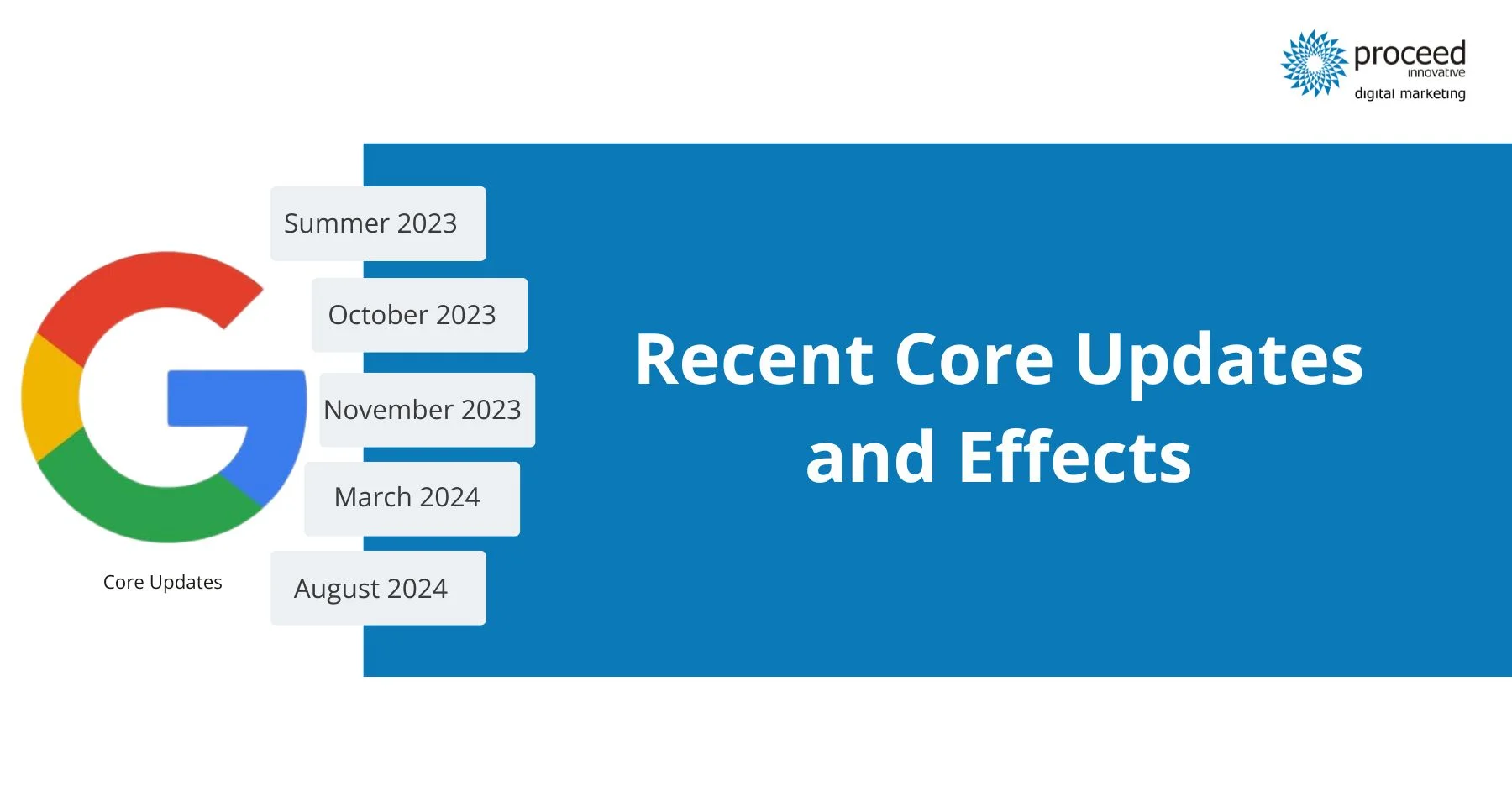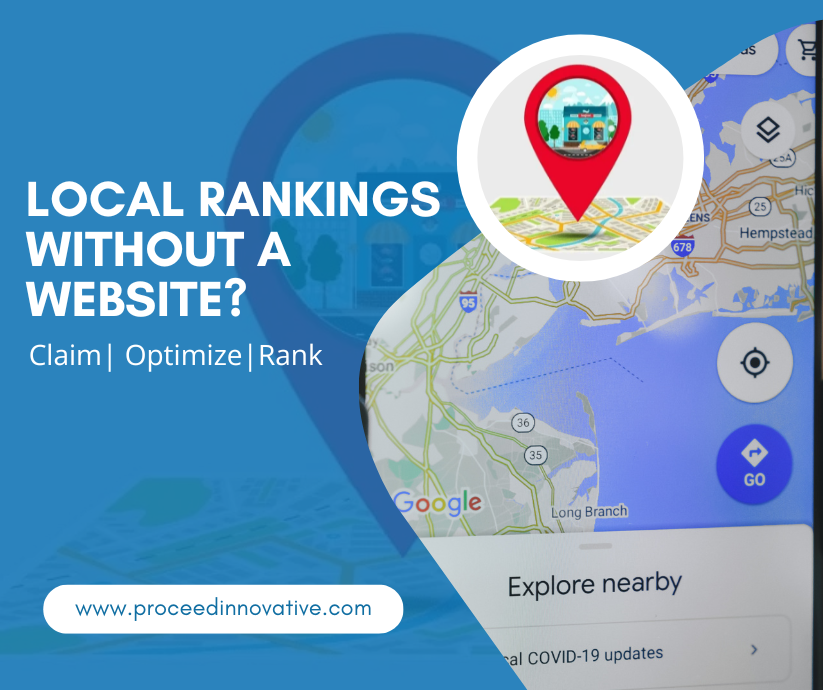Google updates are nothing new as Google has been updating how their search algorithm works periodically for over two decades. When these updates occur, the digital marketing community assesses and responds to the changes to help the websites we manage follow Google’s best practices to continue ranking well in the search engine results pages (SERPs) and bringing in quality traffic.
In the fall of 2023, Google launched multiple core updates that each had a major impact on the digital landscape, followed by another major core update in March of 2024. Many websites were hit hard by these updates, experiencing a drop in rankings and traffic that is still a major problem as many affected websites are yet to recover. If the website for your business has lost rankings and traffic due to these Google core updates, you are not alone as many businesses and websites are still trying to make sense of what these core updates did and how to recover their rankings and traffic to pre-update levels.
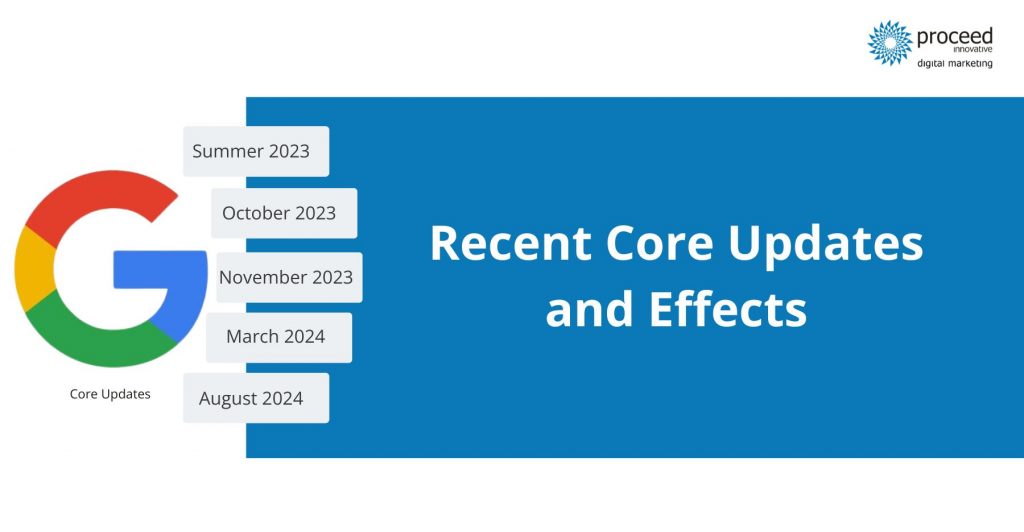
In this guide, we will discuss each of the core updates launched by Google in the fall of 2023 and March of 2024, as well as the smaller updates that occurred in the summer of 2023 leading up to the major updates. We hope that by highlighting the effects of these updates, you can better understand why the performance of your website has been affected.
Summer of 2023 – Broad Core Update and HCU(X)
In the summer of 2023, many people across the digital landscape noticed swings in visibility and rankings, causing many to theorize that Google was testing something with unconfirmed updates. From May through July, many different types of websites including ecommerce sites, review sites, and health/medical websites were experiencing ups and downs in their visibility and rankings.
Then on August 22, 2023, Google rolled out the Broad Core Update which caused some websites to surge but others to drop. The second major update occurred less than a month later on September 14, 2023, known as the Helpful Content Update, or HCU(X). This update uses a machine-learning model as a classifier to identify content it deems to have little value or is not helpful to users. Sites with content identified as unhelpful did not perform well after this update. Many niche sites in particular were hit hard as visibility and clicks plummeted.
The HCU(X) update was a major update that drastically impacted websites considered to have unhelpful content, disruptive ads, and poor user experience. The new machine-learning classifier that was rolled out with this update is now a part of Google’s core ranking system and will be a part of every future update. When the broad core update in March 2024 rolled out, most websites impacted by the September 2023 HCU(X) update dropped even more and none recovered. Some websites were down by as much as 98 percent.
The quality of the content was not the only thing that caused websites to suffer as the sheer number of updates in such a short period of time caused volatility in the SERPs which resulted in websites with good content dropping in the rankings. Google has responded to the concerns many have had after the March 2024 update, stating that some websites could recover with the next update, especially if they make enough changes to improve content and user experience, but not all will recover.
October 2023 – Spam and Broad Core Updates
On October 4, 2023, Google rolled out a spam update to clean up spam including cloaked, hacked, auto-generated, and scraped spam. This update hurt websites as it went after thin content, low quality AI content, link spam, and content that has been stolen or copied. Many sites that were impacted by HCU(X) experienced an even further drop in rankings and traffic with this update.
The October broad core update was rolled out the next day on October 5, 2024. Once again, websites impacted by HCU(X) experienced drops in rankings and traffic. This new update penalizes websites that were “written for search” and not users, including sites that added Google’s People Also Ask (PAA) questions to their pages and overloading content with too much information. However, some websites did experience a surge after being impacted by the August broad core update.
November 2023 – Broad Core and Reviews Updates
The fifth major update to occur in the fall of 2023 is the November 2023 broad core update rolled out on November 2. This update caused some surges and drops, and it reversed many of the surges that websites experienced from the October broad core update.
The sixth and final update of the fall of 2023 is the Reviews Update that was rolled out on November 8. This update was put in place to make sure users see reviews that share in-depth research rather than thin reviews that simply describe products and services. Google also announced that the reviews system will be updated regularly and there will no longer be specific reviews updates announced.
The purpose of these updates is to encourage websites to make significant improvements to the quality of their websites over the long term. This includes improving content to reduce what is considered unhelpful content, improving the user experience of the website, ditching aggressive ads, reducing spam links, and resolving technical SEO issues. However, there were also issues on Google’s end as the many changes made by these updates contributed to volatility that caused many sites to go up and down with rankings and traffic. Even websites that were not penalized for poor content or user experience were negatively impacted by the volatility.
The best way to remediate the effects these updates had on your website is to take a holistic approach to fixing issues regarding content quality and user experience. Improving these areas will make your website more valuable to Google.
March 2024 – Broad Core and Spam Updates
The Broad Core Update launched on March 5, 2024, is believed to be the most complex broad core update from Google. This update included thousands of manual actions, and it took 45 days to fully roll out. There were multiple tremors and reversals in rankings and traffic during the roll out that became more volatile after the roll out ended.
Spam Update
The 2024 spam update hit first and introduced new policies to help reduce the following issues:
- Scaled content abuse: The update aims to reduce producing content at scale, whether human or AI created. The goal is to discourage the mass generation of low quality and unoriginal content meant to manipulate rankings.
- Expired domain abuse: This is the purchase and repurposing of expired domains to boost the rankings of low quality or unoriginal content.
- Site reputation abuse: This is when third parties publish low quality content on a website with a strong reputation to leverage its reputation to benefit from its rankings. The enforcement of this policy was launched on May 5, 2024.
The manual actions of this update included the deindexing of directories and entire websites, which led to massive drops in rankings. The deindexing of many of these websites may not have been warranted.
Main Core Update
Director of Product Search at Google Elizabeth Tucker stated that the new core update will “collectively reduce low-quality, unoriginal content in search results by 40%.” This update made changes simultaneously to multiple core systems and people from Google warned that there will be fluctuations in rankings as each of these systems are updated and begin to reinforce each other.
Many of the things mentioned earlier with the previous updates were baked into this one large update, including reviews updates, spam updates, and curbing unhelpful content, aggressive ads, poor user experience, and content created for search instead of users. The update ended up reducing low-quality, unoriginal content in the search results by 45 percent, more than the expected 40 percent, which led to massive volatility. Some websites initially surged and then dropped while other websites experienced the opposite. Many were still reporting volatility in their rankings and traffic as late as May.
August 2024 Core Update
While the previous updates from the fall of 2023 and March 2024 did help improve the quality of search results by displaying content considered to be genuinely useful, these updates had a negative impact on small and independent websites. Many independent publishers that created useful and original content got buried in the rankings while larger publishers surged.
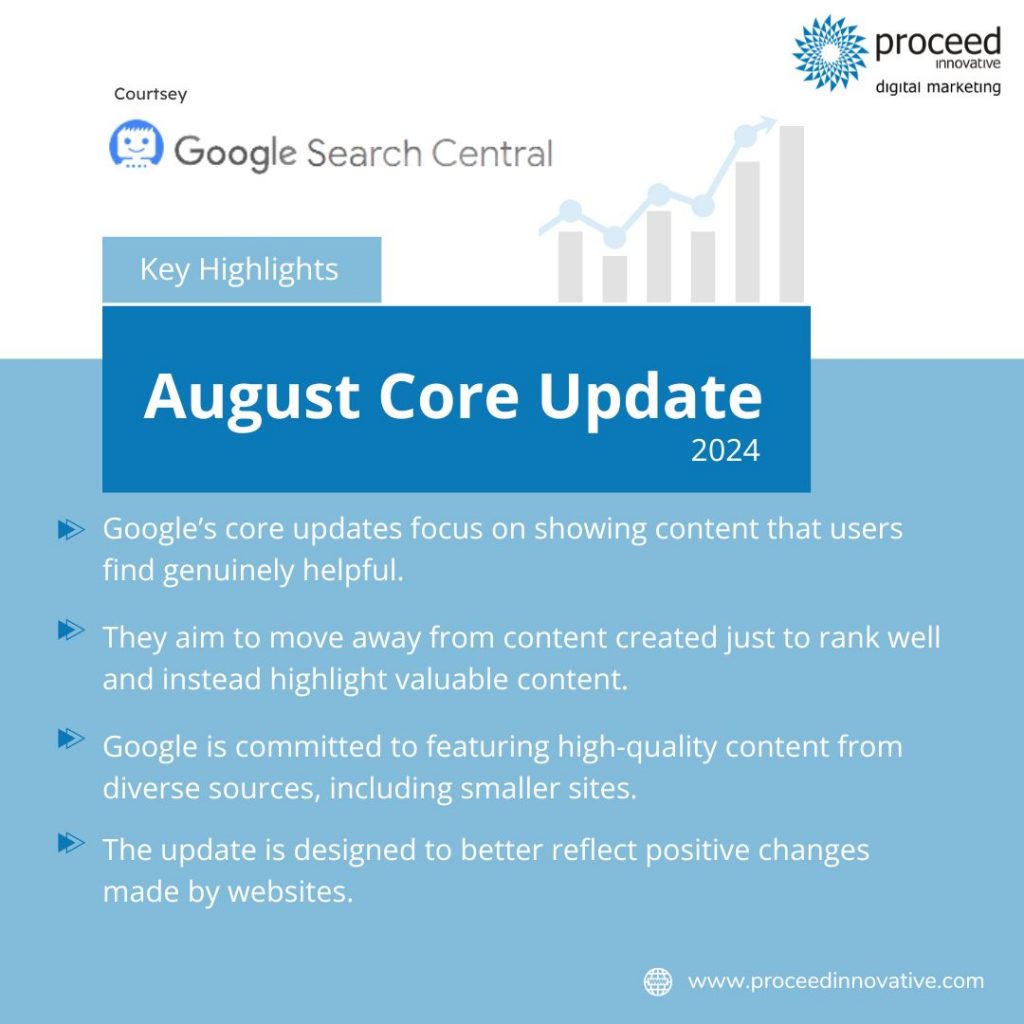
Google launched the August 2024 core update in response to the feedback they have gotten from small and independent websites that were adversely affected by the previous updates. The main goals of the August 2024 update are to promote useful content from small and independent publishers and identify the improvements websites have made since the previous updates so they can recover in the rankings.
So far, some of the websites impacted by the previous updates are seeing an improvement in rankings, but it is difficult to tell how much of an improvement these sites will experience until the roll out is complete. Google also confirmed that there was a ranking bug unrelated to the update that was affecting rankings and traffic. The ranking bug issue has since been resolved.
Main Takeaways from the 2023 and 2024 Google Updates
The period from late August 2023 through the completion of the last core update in April 2024 had an unprecedented number of updates from Google to help improve user experience and content quality gradually over time. The recent August 2024 core update was rolled out to help reverse some of the effects of the SERP volatility caused by the previous updates.
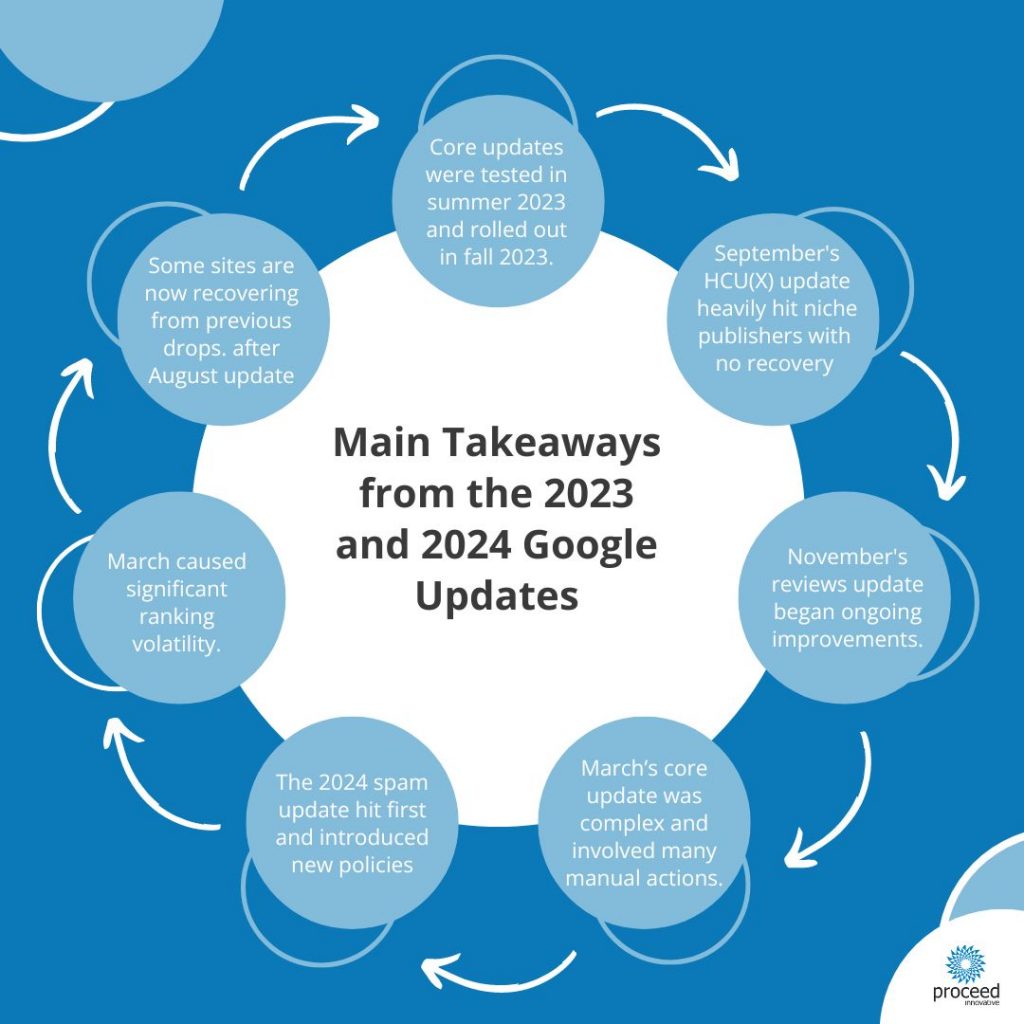
The following is a summary of the main takeaways of this series of updates and their effects:
- Testing for these core updates was done in the summer of 2023 to prepare for the official roll outs in the fall of 2023.
- The HCU(X) update in September had a massive impact on niche publishers and so far, none have recovered.
- The reviews update of November 2023 was the start of regular and ongoing improvements to the review system.
- The March core update is one of the most complex roll outs Google has ever launched.
- Thousands of manual actions were part of the new spam policies.
- The next core update could help some websites recover that were impacted by HCU(X).
- After the completion of the March core update, there was a lot of volatility that caused ups and downs for many websites.
- The August 2024 core update was rolled out to help stabilize the volatility and promote small and independent websites that were impacted by the previous updates.
- So far, some of the websites that dropped in the rankings due to the previous updates are showing signs of recovery.
How Proceed Innovative Helps with Digital Marketing
 There are a lot of businesses, ecommerce websites, niche publishers, directories, review sites, and more that are still reeling from the drops in visibility, rankings, and traffic caused by this series of Google updates. If your website has yet to recover, there are many more websites just like yours that are also still trying to make the necessary changes to remediate the damage and recover their visibility and rankings.
There are a lot of businesses, ecommerce websites, niche publishers, directories, review sites, and more that are still reeling from the drops in visibility, rankings, and traffic caused by this series of Google updates. If your website has yet to recover, there are many more websites just like yours that are also still trying to make the necessary changes to remediate the damage and recover their visibility and rankings.

The main point of all these Google updates is to improve the user experience by cutting down on spam, aggressive ads, and low-quality, unoriginal, and unhelpful content and reviews. The best approach to reverse the effects of these updates is to take a holistic approach that involves improving the quality of your content, ensuring your website provides a good user experience, and using technically sound SEO techniques. If you make enough good changes to your website, it is possible your site will experience a surge when the next core update is launched.
At Proceed Innovative, our experts are devoting our time and resources to better understanding the effects of these updates so we can best serve our clients. We are fortunate enough to have many of our client’s websites still performing well after these updates and we can help websites that are struggling with improved, user-friendly web design, high quality content, and sound SEO strategies to boost your online visibility and generate more business opportunities.
For more about our digital marketing services, you can call Proceed Innovative at (800) 933-2402 or submit a contact form.

